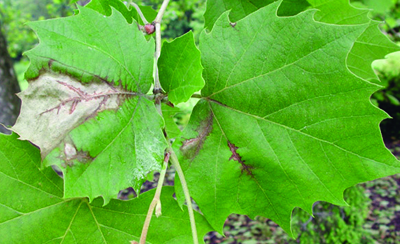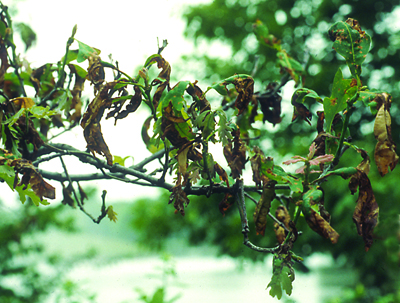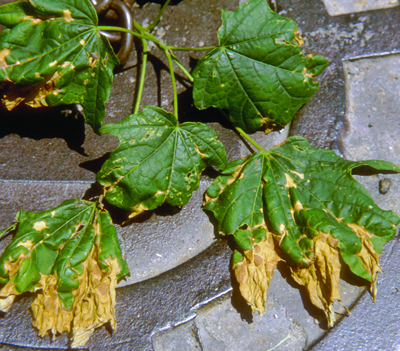Anthracnose -- diseases of shade trees
July 31, 2015
Cause
Anthracnose refers to a symptom rather than a specific fungus.
Hosts
Different fungi produce anthracnose on specific host plants, as shown in the table on pages 86-87. Many plant diseases and weather stress cause similar symptoms. Don’t rely on symptoms alone. Confirm your diagnosis at by sending a sample to MSU Diagnostic Services, where microscopic identification of spores is used for a positive I.D.
Symptoms
In general, anthracnose symptoms are worse after cool, wet springs. Spores have an extended opportunity to wash from branch and twig cankers to new leaves and shoots.

Sycamore anthracnose.
Anthracnose symptoms on white oak in spring
Anthracnose on oak usually occurs in the lower crown.
Compare with oak wilt
The early symptoms of oak wilt may appear similar, but appear in July and begin in the upper part of the tree.


Ash anthracnose symptoms (left). Shade anthracnose oak (right).
Management
Sanitation is important in managing anthracnose. Rake up and destroy fallen leaves to reduce source of inoculum. Remove diseased and dead wood and prune trees to improve air drainage. Fungicides are usually not needed, but fertilization may help trees that are heavily defoliated.

Symptoms of anthracnose on maple.
Anthracnose as seen on different types of trees | ||||
|---|---|---|---|---|
|
Host |
Sexual (S) Asexual (A) stages |
Plant parts affected/symptoms |
Susceptibility/Resistance |
Conditions favorable for disease |
|
Oak |
Apiognoma quercina (S) Discula quercina (A) |
(A) Leaves and new shoots shrivel or turn brown; leaves develop small brown spots or lesions near veins, twig dieback before budbreak in spring. (S) Overwinters on allen leaves. |
Most oaks. White and bur oaks are the most susceptible. |
Wet weather in spring with temps in 64-82°F range. |
|
Sycamore |
Apiognoma veneta (S) Discula platani (A) |
(S) overwinters on fallen leaves. (A) overwinters on infected twigs and bark- infects buds, new shoots, leaves and 1 yr. old twigs. Leaf lesions develop near veins. Chronic twig infections produce witches’ brooms. |
Sycamore and planetree are susceptible. |
61-68° F + wet weather favors leaf nfection; mid-50’s around bud break favors shoot blight. (A) produces secondary infections during growing season. |
|
Ash |
Apiognoma errabunda |
Overwinters on infected twigs and leaf petioles. Water-soaked spots or brown blotches on new shoots and leaves; small oval-shaped cankers on twigs. |
Green ash is more resistant than other ash species. |
Repeating cycles of infection occur during wet weather |
|
Maple |
Kabatiella apocrypta others |
Young leaves and shoots shrivel, turn black. Older leaves develop lesions, usually near leaf veins |
Norway, red, silver, Japanese, sugar maple, and boxelder are susceptible. |
Cool, wet weather (50-55°F ) in spring and/or summer. |
|
Walnut |
Gnomonia leptostyla (S) Marssonia juglandis (A) |
(S) Overwinters on fallen leaves, rachises, and husks. (A) Leaves develop small brown spots with yellow margins. |
Black walnut, butternut |
Initial infection in spring by spores from (S) transmitted by wind, rain; 75-79°F favors nfection of leaves (A) produces repeating cycles of infection during wet weather. |
Print a PDF of this page: Anthracnose-- diseases of shade trees



 Print
Print Email
Email



